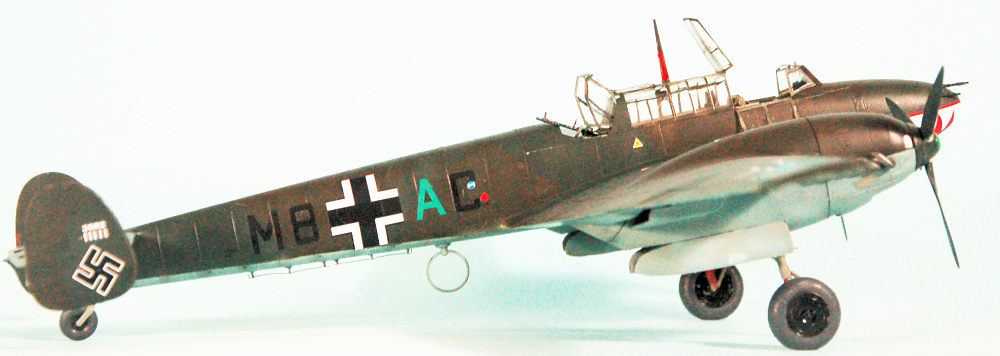
| KIT #: | 8201 |
| PRICE: | $49.95 SRP\ |
| DECALS: | Five options |
| REVIEWER: | Tom Cleaver |
| NOTES: |

| HISTORY |
The Bf 110 Zerstörer (Destroyer) was designed as a long-range heavy fighter and fighter-bomber. In the escort role, it demonstrated that a heavy twin-engined aircraft could not compete as an air superiority fighter with single-engine opponents.
Once the
airplane was powered with the DB601 engine, it proved to have good performance
and served with initial success in the early campaigns in Poland, Norway and
France. The lack of agility could be mitigated with the correct tactics, which
involved staying in the vertical plane and avoiding close-in maneuvering combat
with its opponents. The aircraft’s weakness in the air combat role was revealed
during 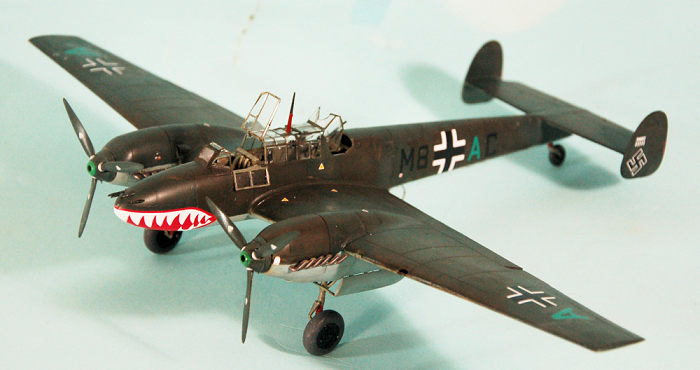 the Battle of Britain, which also allowed it to demonstrate its ability
as a high-speed fighter bomber operating with SKG 210. After the Battle of
Britain the Bf-110 enjoyed success period as a strike aircraft in other
theatres.
the Battle of Britain, which also allowed it to demonstrate its ability
as a high-speed fighter bomber operating with SKG 210. After the Battle of
Britain the Bf-110 enjoyed success period as a strike aircraft in other
theatres.
MajorErich Groth was born January 4, 1907 in Wesermünde and joined the Luftwaffe shortly after its formation. By the outbreak of war, he was serving with II/ZG 76, and became Gruppenkommandeur on January 1, 1940; with the unit’s sharkmouth marking, it became known as the “Haifisch Gruppe.” Eventually, Erik Shilling would spot a photo of one of their airplanes and it would inspire the famous “Flying Tiger” sharkmouth of the AVG. Having scored 12 aerial victories in the Bf-110, making him one of the leading experte on the type, he was awarded the Knights Cross of the Iron Cross on October 1, 1940. Promoted to Kommodore of ZG 76 in August 1941, he crashed in bad weather north of Bergen on August 8, 1941 on his way to northern Norway to assume command. By that time he had scored 13 aerial victories.
| THE KIT |
 Beginning in 2007, Eduard released all variants of the Bf-110 series,
starting with the Bf-110E, followed in 2008 by the Bf-110C and Bf-110D, and
the Bf-110G-2 day fighter and G-4 night fighter in 2009.
Beginning in 2007, Eduard released all variants of the Bf-110 series,
starting with the Bf-110E, followed in 2008 by the Bf-110C and Bf-110D, and
the Bf-110G-2 day fighter and G-4 night fighter in 2009.
The Bf-110C-2 is the “classic” Battle of Britain aircraft. Decals are provided for five different aircraft, carrying a variety of additional armament.
| CONSTRUCTION |
The Eduard Bf-110 series is very “fiddly” in construction. That said, a modeler willing to put in the necessary effort will be rewarded by what has to be the best and most accurate Bf-110 models in 1/48 scale so far released.
Perhaps the
biggest problem for most modelers is that - like most kits made with features
that can be displayed open or dropped, or in any position outside of closed up
for flight, those parts fit better in that position than they do if one attempts
to close them up. This is nowhere m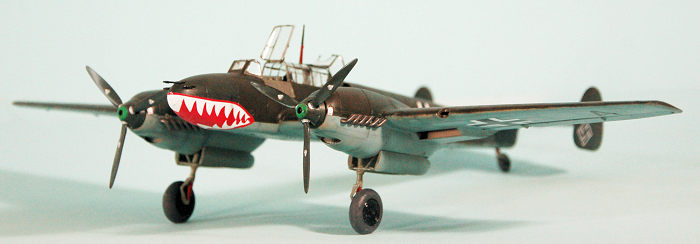 ore noticeable than with the nose. The upper
gun cover is just a bit short in length, and if one has already assembled the
lower nose portion to the fuselage, there will be a considerable bit of
shimming, puttying, sanding and re-scribing necessary to get a nice smooth nose.
ore noticeable than with the nose. The upper
gun cover is just a bit short in length, and if one has already assembled the
lower nose portion to the fuselage, there will be a considerable bit of
shimming, puttying, sanding and re-scribing necessary to get a nice smooth nose.
There is however, an easier way to deal with this. I did not use any of the interior nose parts, and did not attach the forward fuselage bulkhead. Instead, I glued the upper and lower nose parts together, then sanded the rear of the nose cap so it was straight all around, and then did the same to the forwards fuselage, test fitting as I did so. When fit was perfect, I then ran an Evergreen strip around the interior of the forward fuselage to provide a gluing surface, and then attached the nose. There was no need for putty or rescribing. The only “difficult” part of this would involved cutting off the gun barrels and sliding them into the proper holes once everything else was completed. And that is a much better solution than trying not to break them off assembling them before finishing all other assembly and painting.
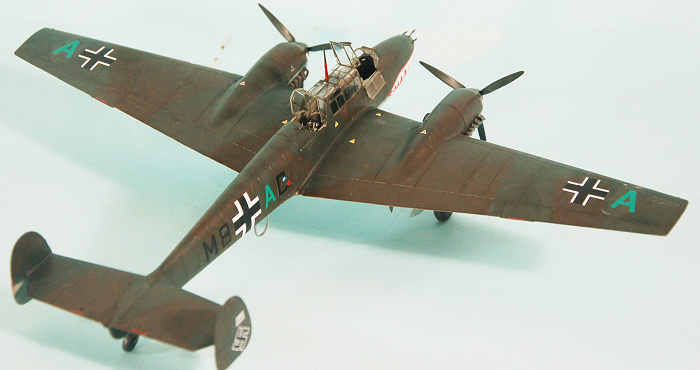 Before I did
all that to the nose, however, I painted and assembled the cockpit. There are a
lot of small parts, and the photoetch parts are again “fiddly,” but patience and
the use of a magnifier lamp paid off with a cockpit that looked better than that
in the 1/32 Dragon kit. When that was done I assembled the fuselage and attached
the nose cap.
Before I did
all that to the nose, however, I painted and assembled the cockpit. There are a
lot of small parts, and the photoetch parts are again “fiddly,” but patience and
the use of a magnifier lamp paid off with a cockpit that looked better than that
in the 1/32 Dragon kit. When that was done I assembled the fuselage and attached
the nose cap.
The wings and engines are not difficult, though there are a lot of small parts to assemble in the wheel well; these result in the best-looking wheel wells of any other 1/48 Bf-110 kit, and are done in very petite detail. Once again, taking one’s time and using both patience and the magnifier lamp will have a good result.
I finished off by attaching the fixed canopy and windshield. I definitely appreciated Eduard’s provision of pre-cut masks for the multiple-panel canopy, which made everything very easy. I also attached the landing gear at this point so the model would be able to sit without lying on a surface while paint was drying.
| COLORS & MARKINGS |
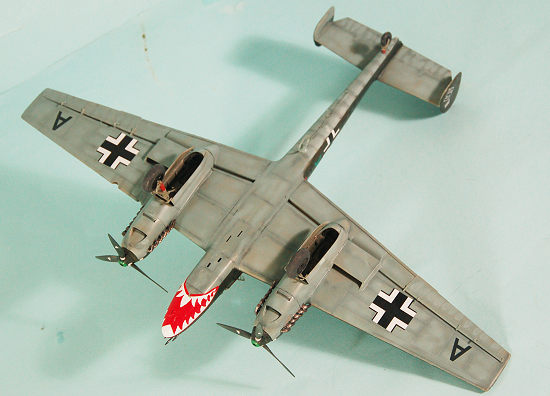 I first gave
the model an overall primer coat of Tamiya “Sky Grey” to be sure that all
offending seams were filled. I then “pre-shaded” the model with flat black
airbrushed over the panel lines. I then painted the area of the white fuselage
stripe and the areas that would be painted yellow with Tamiya “Flat White.” I
then painted the yellow areas, and then all these were masked off.
I first gave
the model an overall primer coat of Tamiya “Sky Grey” to be sure that all
offending seams were filled. I then “pre-shaded” the model with flat black
airbrushed over the panel lines. I then painted the area of the white fuselage
stripe and the areas that would be painted yellow with Tamiya “Flat White.” I
then painted the yellow areas, and then all these were masked off.
The model was then painted in the standard early war scheme of RLM 70/71 splinter pattern upper surfaces and RLM 65 lower surfaces. When that was all dry, I gave the model a coat of Xtracrylix Gloss Varnish.
I did the markings option for Major Erich Groth’s M8+AC from Stab.II/ZG76, flown in the Norway campaign, the Western Europe campaign, and lost during the Battle of Britain. The excellent Eduard decals went down without problem.
I applied exhaust stains using Tamiya “Smoke,” then unmasked the canopy. I attached the props, the very nice Aerocast resin wheels, and gear doors. I finished off with the bomb ordnance.
| CONCLUSIONS |
Yes, the kit is fiddly, and yes, it could have been designed to be more “modeler-friendly.” That said, the average modeler, applying care and patience and following the instructions, as well as my little secret about the nose, can create a very nice model with this kit. This is the most accurate series of Bf-110s released by anyone, and the kits are well worth their price for value. Recommended for any Luftwaffe fan.
18 October 2018
Copyright ModelingMadness.com
If you would like your product reviewed fairly and fairly quickly, please contact the editor or see other details in the Note to Contributors.
Back to the Main Page Back to the Review Index Page Back to the Previews Index Page